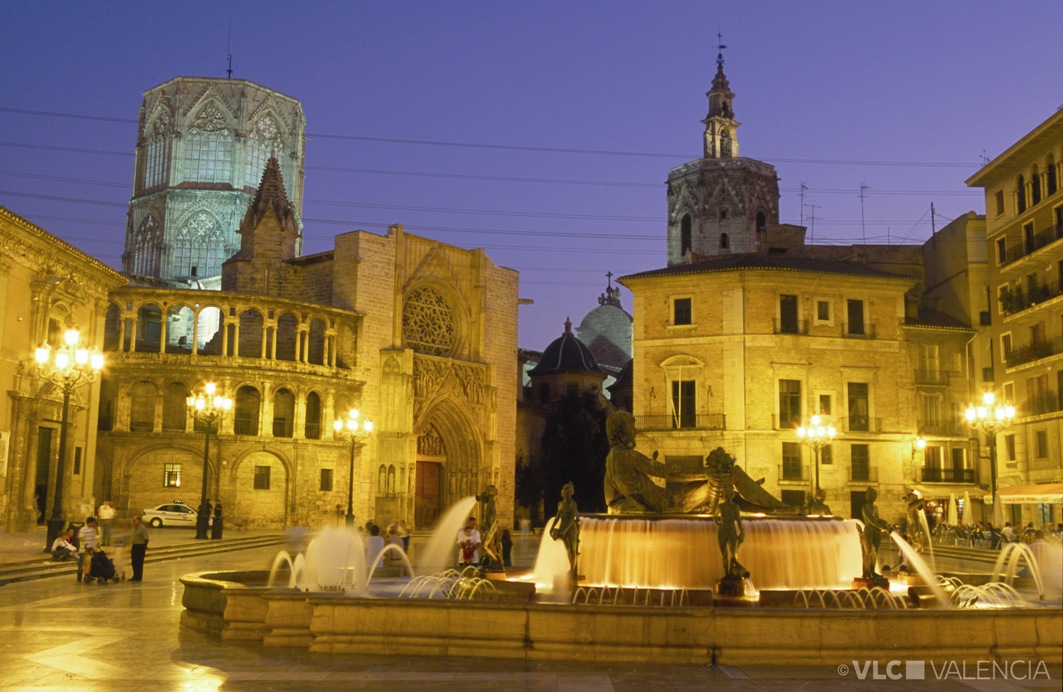
PLAZA DE LA VIRGEN: La Catedral & El
Miguelete.
The
El Miguelete is was build in mid of the thirteenth century and it is located across from the Plaza de la Reina, in the heart of the city.
There
are several architectural styles in its construction like Renaissance and Baroque in the chapels and the main door. The door Almonia
is was build in
Romanesque style while
the Miguelete,
the dome and the Door of the Apostles were build in the Gothic style.
Visiting
hours are 10 to 18 hours on weekdays, Saturdays 10 to 17:30 and Sundays and holidays from 14 to 17.30 hours. Admission is € 2.70 and includes a visit to the Cathedral Museum.
The Micalet is octagonal bell tower adjoining the Cathedral. Is 50 meters high and can be climbed by a narrow staircase of 207 steps inside. The access
costs € 2.
The
Plaza de la Virgen is surrounded by extraordinary buildings and it is a home to
lots of pigeons. The Nuestra Señora de los Desamparados on the eastern side of
the square, and on the western side is the Gothic Palau de la Generalitat are
the seat of government for the Valencia region. Also in the square there are
some cafes with plethora of outside seating for the obligatory people watching.
In the centre of the square is a magnificent fountain which represents the
irrigation of the Turia River.
PLAZA DEL MERCADO: Lonja de la Seda,
Santos Juanes and Mercado Central
The Market Square is the meeting point for
merchants between Central Market and the Lonja
and is located
on the square of the same name, close to Central Market and the Lonja de la Seda. Among the Central Market and the Lonja, the comings and goings of merchants in ancient times was constant.
The
central market occupies an area of 8,000 square meters. It is made of metal,
glass, wood and ceramics. Comprising a ground floor and basement. It is covered by original domes and roofs at different heights, full of light and color.
It creates an
effect produced by
penetrating light
through the
stained glass windows. Stands its airy structure topped
by a
beautiful dome.
It was restored and
recovered as
a leisure
center. The
interior now
houses several
restaurants, cafes and
shops
The
building of Lonja de la Seda is designed on a commercial basis and has a marked symbolic character looks like a fortress that give its thick walls and battlements. The representation of paradise was presented on them in which the interior columns would be the trunks of palm trees and the domes represent the celestial dome.
The set
consists of four
parts: the
hiring hall where commercial
transactions were
conducted, consisting of one large
room divided into three longitudinal naves by
columns very
traditional helical Levantine Gothic,
with a
height of 16 meters,
the tower is composed
of two upper
floors and ground
floor where the
chapel stood the
prison, the
Consulate of
the Sea, where
they settled disputes
between merchants
that began in
1498 and
was completed in
1548, hence the influence
of Renaissance
and finally Patio de
los Naranjos.
The
Santos Juanes is situated opposite the
Lonja de la Seda. Built
in Gothic style but ultimately finished in
Baroque style after a
fire that severely
damaged it in
1603. It
has a single nave
covered by ribbed
vaults and
fine Gothic
decoration outside. The
interior is
very luxurious. Inside are
kept sculptures
and paintings. Nostra,
the image of Senyora to Peu
de la
Creu, the sixteenth century Etuve believed
to be hidden
for centuries from
the Hispanic Church iconographic
image may be
the oldest
in Valencia.
It also highlights the
painting that decorates
the chapel, the
altarpiece of
the master Manuel Vergara or fifteenth century
altarpiece with
the theme of
the mystery of the
Trinity.
LA CIUDAD DE LAS ARTES Y LAS CIENCIAS
The City of Arts and Sciences in
Valencia is an unique complex dedicated to scientific and cultural diffusion
which is made up of five main elements: the Hemisfèric (IMAX cinema and digital
projections), the Umbracle (a landscaped vantage point and car park), the Príncipe
Felipe Science Museum (an innovative centre of interactive science), the
Oceanográfico (the largest aquarium in Europe with over 500 marine species) and
the Palau de les Arts Reina Sofía (which takes care of the operatic program).
The Ágora gives the complex a multifunctional space.
BIOPARC
Bioparc in
Valencia is a new
generation zoo, where
you can enjoy equatorial
Africa, the African Savannah, and
Madagascar in
a huge space of
100,000 square meters.The
most novel feature
of this park is its
design, which allows to
observe the animals with
barely visible
barriers. There
are no boxes or
cages.
The natural surrounding for animals were
recreated and separate
visitors from
the animals by hidden to
the eye pits,
streams or
crystals.
In this
new conception of zoo
different African ecosystems such as savannah,
Forests of
Madagascar and Equatorial
Africa were faithfully
recreated. They
reproduce of the original vegetated bioclimatic
zones in
each area, as well as local vegetation and
reproductions or
replicas supports large rocks,
caves and giant baobabs.
In
the middle
of the park,
stands the
amphitheater,
ample outdoor multidisciplinary
capacity for
1,000 people, which will
offer visitors
the opportunity
to observe behaviors of birds
and mammals.